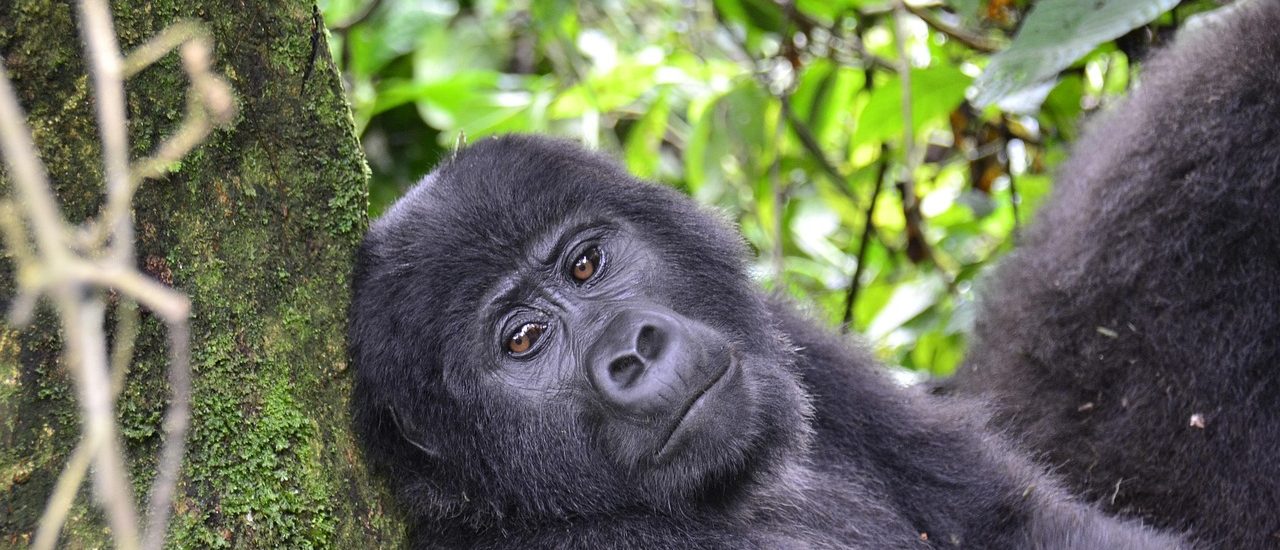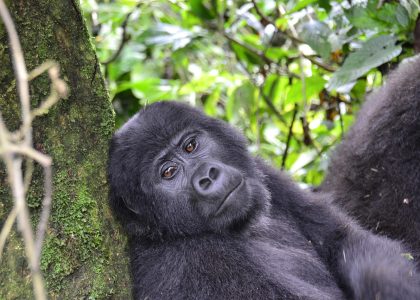Welcome to the second article in our Wazimba Travel Uganda series, where we delve into Uganda’s most iconic and life-changing wildlife experience—mountain gorilla trekking. Few encounters in the natural world can match the profound impact of gazing into the intelligent eyes of a mountain gorilla in their misty forest home. Uganda, protecting more than half of the world’s remaining mountain gorillas, offers the planet’s most accessible and intimate gorilla experiences, combining conservation success with transformative travel memories.
The Mountain Gorilla: A Conservation Miracle
Mountain gorillas represent one of conservation’s greatest success stories. From a critically low population of just 620 individuals in 1989, dedicated conservation efforts have increased their numbers to over 1,100 today—with Uganda home to approximately 460 of these magnificent creatures. This remarkable recovery demonstrates how responsible tourism can directly fund conservation while providing local communities with sustainable livelihoods.
These gentle giants, sharing 98% of human DNA, live in complex family groups led by dominant silverback males who can weigh up to 220 kilograms. Despite their imposing size, mountain gorillas are primarily vegetarian, spending most of their day foraging for leaves, stems, bark, and fruit in the dense montane forests they call home.
Bwindi Impenetrable National Park: The Gorilla Capital
Bwindi Impenetrable National Park, a UNESCO World Heritage Site in southwestern Uganda, protects approximately 400 mountain gorillas across its 331 square kilometers of ancient forest. This “impenetrable” forest—aptly named for its dense vegetation—represents one of Africa’s oldest ecosystems, harboring not only mountain gorillas but also over 350 bird species, 200 butterfly species, and 120 mammal species.
The Bwindi Experience
Bwindi offers gorilla trekking from four different sectors, each providing unique experiences:
Buhoma Sector: The original gorilla trekking base offers the most developed infrastructure and easiest access. Home to habituated groups including the famous Mubare family—the first gorilla group opened to tourism in 1993. The rolling hills and relatively open forest make this sector ideal for visitors seeking less strenuous treks.
Ruhija Sector: Positioned at higher altitude, Ruhija provides excellent birdwatching opportunities alongside gorilla trekking. The sector’s elevated position offers spectacular views across the forest canopy and is home to some of Bwindi’s most photogenic gorilla families.
Rushaga Sector: The newest and most popular sector, Rushaga hosts the largest number of habituated gorilla groups, including the massive Mishaya group with over 20 members. The sector’s varied terrain provides diverse trekking experiences, from gentle walks to challenging climbs.
Nkuringo Sector: Perched on Bwindi’s steep southern escarpment, Nkuringo offers the most dramatic landscapes and challenging treks. The sector’s high altitude provides stunning views across the Virunga volcanoes and Democratic Republic of Congo.
Wazimba Travel Tips for Bwindi:
- Book accommodation close to your trekking sector to minimize early morning travel
- The dry seasons (June-August and December-February) offer easier trekking conditions
- Pack lightweight rain gear regardless of season—Bwindi receives rain year-round
- Choose your sector based on fitness level: Buhoma for easier treks, Nkuringo for adventure seekers
- Allow 2-3 days in the area to account for weather delays and enjoy additional activities
Mgahinga Gorilla National Park: Where Gold Meets Silver
Mgahinga Gorilla National Park, Uganda’s smallest national park, protects the Ugandan portion of the Virunga Massif—a chain of volcanic mountains shared with Rwanda and Democratic Republic of Congo. While smaller than Bwindi, Mgahinga offers equally magical gorilla encounters with the added drama of volcanic landscapes.
The Nyakagezi Group
Mgahinga hosts one habituated mountain gorilla group—the Nyakagezi family. This dynamic group, known for their cross-border movements between Uganda, Rwanda, and Congo, provides intimate encounters with typically 8-10 members led by the impressive silverback Mark. The group’s smaller size often allows for more personal interactions and better photography opportunities.
Beyond Gorillas: The Complete Mgahinga Experience
Mgahinga’s volcanic landscape offers unique experiences beyond gorilla trekking:
Golden Monkey Tracking: These endangered primates, found only in the Virunga region, display stunning golden fur and playful behaviors. Golden monkey tracking provides an excellent complement to gorilla trekking with less physical demands.
Volcano Climbing: Scale Mount Sabinyo to stand at the point where Uganda, Rwanda, and Congo meet, or conquer Mount Gahinga for spectacular crater views.
Batwa Cultural Trail: Former forest dwellers share their profound knowledge of the forest through guided walks, demonstrating traditional hunting techniques, medicinal plant uses, and cultural practices.
Wazimba Travel Tips for Mgahinga:
- Combine gorilla trekking with golden monkey tracking for maximum primate experiences
- The park’s higher altitude can be cold—pack warm layers even in tropical seasons
- Volcano climbing requires good fitness levels but rewards with incredible views
- Support the Batwa community through cultural trail participation
- Consider staying in nearby Kisoro town for budget-friendly accommodation options
Gorilla Habituation vs. Standard Trekking
Uganda offers two distinct gorilla experiences, each providing different levels of interaction:
Standard Gorilla Trekking
- One hour with fully habituated gorilla groups
- Groups of up to 8 visitors
- Available daily across all sectors
- Permits cost $700 per person
- Suitable for all fitness levels (depending on group location)
Gorilla Habituation Experience
- Four hours with semi-habituated gorilla groups
- Maximum 4 visitors per group
- Available only in Bwindi’s Rushaga sector
- Permits cost $1,500 per person
- Involves accompanying researchers in the habituation process
The habituation experience provides deeper insights into gorilla behavior and conservation efforts while contributing more directly to research funding. However, standard trekking offers excellent value and accessibility for most visitors.
Wazimba Travel Recommendations:
- Choose habituation for photography enthusiasts and wildlife researchers
- Standard trekking suits families and first-time visitors
- Book habituation experiences 6-12 months in advance due to limited availability
- Consider your physical fitness—habituation involves longer, more challenging treks
Planning Your Gorilla Trek: Essential Preparation
Physical Preparation
Mountain gorilla trekking involves hiking through dense forest on steep, often muddy terrain. While no technical climbing skills are required, basic fitness and preparation enhance your experience:
- Begin cardiovascular training 2-3 months before travel
- Practice hiking with a day pack on uneven terrain
- Strengthen leg muscles for steep ascents and descents
- Consider altitude if you’re sensitive to elevation changes
What to Pack for Gorilla Trekking
Essential Gear:
- Sturdy, broken-in hiking boots with good ankle support
- Lightweight rain jacket and pants
- Long-sleeved shirts and pants to protect against stinging nettles
- Gardening gloves for gripping vegetation
- Small daypack for water and snacks
- Camera with extra batteries (no flash photography allowed)
Wazimba Travel Provides:
- Professional walking sticks for all trekkers
- Porter services to carry heavy bags and assist with difficult terrain
- Emergency communication devices for safety
- First aid support and emergency evacuation insurance
Gorilla Trekking Etiquette
Responsible gorilla tourism requires strict adherence to guidelines that protect both gorillas and visitors:
Health Requirements:
- Visitors showing signs of illness will not be permitted to trek
- Maintain 7-meter distance from gorillas at all times
- Wear face masks when within close proximity
- No eating, drinking, or smoking near gorillas
Behavioral Guidelines:
- Keep voices low and movements slow
- Avoid direct eye contact with silverbacks
- Do not touch gorillas under any circumstances
- Follow guide instructions immediately and without question
- Photography allowed without flash only
Conservation Impact: How Your Visit Makes a Difference
Every gorilla trekking permit directly funds conservation efforts that protect mountain gorillas and their habitat:
Conservation Funding: 20% of permit fees goes directly to local communities for development projects, creating incentives for conservation rather than forest conversion.
Anti-Poaching Efforts: Tourism revenue funds ranger salaries, equipment, and training programs that maintain 24/7 protection for gorilla families.
Research Programs: Visitor fees support ongoing research into gorilla behavior, health monitoring, and habitat protection strategies.
Community Development: Tourism provides employment for guides, porters, lodge staff, and craft makers, creating sustainable alternatives to forest exploitation.
Success Stories
The Bwindi Community Hospital, built with tourism revenue, provides healthcare for over 60,000 local residents while serving as a research base for gorilla health monitoring. Similarly, school construction projects funded by gorilla tourism have increased local education rates by over 40% in the past decade.
Beyond the Trek: Complementary Experiences
Maximize your gorilla region visit with additional activities that showcase the area’s biodiversity and culture:
Bwindi Forest Walks
Guided forest walks reveal Bwindi’s incredible biodiversity beyond gorillas. Expert guides identify medicinal plants, demonstrate traditional forest uses, and spot forest elephants, various primate species, and endemic birds.
Community Cultural Encounters
Visit local villages to learn traditional crafts, participate in banana beer brewing, or join cultural dance performances. These authentic interactions provide insights into how communities have adapted to living alongside mountain gorillas.
Bird Watching Expeditions
Bwindi hosts 23 endemic Albertine Rift species found nowhere else on Earth. Early morning birding walks often yield sightings of African green broadbill, Shelley’s crimsonwing, and other rare forest species.
Lake Mutanda and Lake Bunyonyi
These scenic highland lakes offer relaxation after gorilla trekking with opportunities for canoeing, island visits, and spectacular photography of terraced hillsides and traditional dugout canoes.
When to Visit: Seasonal Considerations
Dry Seasons (June-August & December-February)
Advantages:
- Easier trekking conditions with less mud
- Better road access to remote lodges
- Clearer weather for photography
- Lower chance of trek cancellations
Considerations:
- Higher accommodation rates and crowd levels
- More competitive permit availability
- Less lush forest vegetation for photography
Wet Seasons (March-May & September-November)
Advantages:
- Lower accommodation rates and fewer crowds
- Lush, green forest perfect for photography
- Better availability of last-minute permits
- More active wildlife due to abundant food sources
Considerations:
- Muddy, slippery trekking conditions
- Possible road access difficulties
- Higher chance of weather-related delays
- More challenging photography conditions
Wazimba Travel’s Seasonal Recommendations:
- First-time visitors should choose dry seasons for optimal conditions
- Photography enthusiasts often prefer wet season’s lush vegetation
- Budget-conscious travelers benefit from wet season rates
- Adventure seekers enjoy wet season’s additional challenges
Accommodation: From Luxury to Community Stays
Luxury Options
Buhoma Lodge: Bwindi’s premier accommodation offers elegant cottages with forest views, gourmet dining, and spa services.
Clouds Mountain Gorilla Lodge: Positioned dramatically on Nkuringo’s ridge, this stone-and-timber lodge provides luxury with spectacular views.
Mount Gahinga Lodge: Near Mgahinga, this eco-luxury property combines comfort with cultural authenticity through Batwa-inspired design.
Mid-Range Choices
Silverback Lodge: Comfortable bandas with excellent service in Buhoma sector.
Ichumbi Gorilla Lodge: Eco-friendly accommodation in Rushaga with community involvement.
Travellers Rest Hotel: Historic property in Kisoro town with mountain views and budget-friendly rates.
Community-Based Options
Ride 4 a Woman: Community guesthouse supporting local women’s empowerment projects.
Bwindi Backpackers Lodge: Budget-friendly option with camping and dormitory facilities.
Wazimba Travel Accommodation Strategy:
- Book luxury lodges 6-12 months in advance, especially for dry seasons
- Mid-range properties offer excellent value with most amenities
- Community stays provide authentic experiences while supporting local development
- We arrange accommodation based on your trekking sector to minimize travel time
Making Your Gorilla Dreams Reality
Mountain gorilla trekking represents more than wildlife viewing—it’s a profound encounter with our closest relatives in their natural habitat, a conservation success story you help write, and a transformative travel experience that connects you deeply with Africa’s remarkable biodiversity.
As your local East African tour operator, Wazimba Travel ensures your gorilla trekking experience exceeds expectations through expert planning, local knowledge, and commitment to responsible tourism. From securing permits and arranging seamless logistics to providing cultural context and conservation education, we handle every detail of your gorilla kingdom adventure.
In our next article, we’ll explore Uganda’s incredible primate diversity beyond mountain gorillas, venturing into the forests of Kibale National Park—the “Primate Capital of the World”—where chimpanzees and a dozen other primate species await your discovery.
Ready to gaze into the eyes of a mountain gorilla? Contact the Wazimba Travel team to start planning your life-changing gorilla trekking adventure in the Pearl of Africa.






